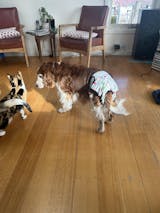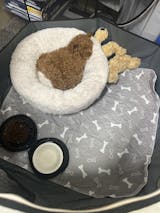How Much to Feed a Puppy by Its Weight/ KG
Puppy food quality is just as crucial as the quantity in a puppy's optimal diet. As a result, we always recommend using a puppy food scale. So you can keep track of how much food your pet consumes.
Having a puppy in the house is a wonderful experience. However, you must be extremely responsible. If you're reading this, you've recently acquired a new best friend and want to provide your puppy with a nutritious diet. We feel they are deserving of nothing but the finest. We'll assist you in selecting a diet that you can feed your pets for the rest of their lives with confidence.

We don't advise manufactured food for your dog and believe that a natural raw diet is the best option.
As they mature and grow, we're here to offer feeding recommendations. Continue reading to learn more about the diet as a whole.
The Right Puppy Foods You Should Start With
There are numerous aspects to consider when it comes to feeding pups. The type of food, the breed size, and the overall nutrition all impact. What you need to know is as follows:
Puppy Food For Nutrition:
Puppy diets are developed with a nutritional balance to help puppies grow healthy and happy. To assist their expanding bodies, look for formulas that are high in high-quality proteins. Fat and carbs provide the energy that energetic and playful pups require, while calcium aids in the development of teeth and bones and DHA aids in the development of a healthy brain and vision.

Puppy Food Based On Their Breed:
Puppies require puppy food, but some breed sizes may benefit from size-specific recipes. If you have a giant breed puppy, a large breed-specific puppy formula may benefit him. Small breed-specific puppy formulae can also help small breeds. Regardless of breed size, the meal should be comprehensive and balanced for developing puppies.
The discrepancy in formulations is due to the different requirements of large and small breeds. Because large dogs are more likely to have joint problems, large breed puppy food should provide adequate nutrition to promote their healthy growth and development.

Smaller breeds may prefer smaller kibble to chew their meal more readily, ensuring that they obtain all the nutrients they require.
"Small breed-specific dog food is vital due to their heightened metabolism," says Purina Nutritionist Karina Carbo-Johnson, MS. This produces a high-energy, nutrient-dense recipe that adults and puppies require to maintain a healthy lifestyle.
Puppy Dry Food VS Wet Food:
Dry kibble is a popular alternative, but it isn't the only one. You'll find both dry and wet puppy foods in the dog food aisles.
This can make deciding what to give your puppy more difficult. You can feed your puppy either wet or dry formula with confidence as long as both are full and balanced for developing puppies.
When it comes to dry versus wet, you and your dog may have a preference. It's also possible to feed a mixture of the two.

"If you're giving your puppy a balance of wet and dry food, it's critically vital to guarantee the total caloric value does not fall short or exceed their daily energy requirement," says Purina Nutritionist Allison Millican, Ph.D. To figure out how much-wet food will replace dry food and vice versa, use the calories shown on the box. This allows you to figure out how much of each product you'll need to suit your puppy's nutritional needs."
"One thirteen-ounce can of wet puppy food, for example, may have 475 kilocalories and replace approximately one cup of a dry puppy formula with a similar kilocalorie content per cup," Millican notes.
Puppies grow at different rates, and their physical condition might alter quickly. As a result, it's critical to keep an eye on your puppy's bodily condition and alter calorie intake as needed to avoid overfeeding or underfeeding.
What to Feed a 6-8 Week Puppy - Advance Puppy Food
Congratulations on the addition of your new four-legged family member. We understand that you want to feed your dog the best puppy food available. However, before you go out and buy the entire puppy food aisle, read our blog to get a better idea of what they require.

During the first six to eight weeks of life, the puppy should remain with the mother and be allowed to nurse whenever they feel like it. It is critical that they nurse from their mother. The finest nutrients come from the mother's milk, which contains antibodies that help protect your puppy from sickness. When a mother develops eclampsia or mastitis, it is sometimes impossible to keep a puppy with her for the first eight weeks. In these scenarios, milk replacers and bottles developed specifically for puppies can be bought at any major pet store.
How Much Water Should a Puppy Drink?
Adult dogs, on average, require one ounce of water per pound of body weight each day. Therefore, growing puppies consume more than their adult counterparts despite their comparatively tiny stature. However, a lot depends on your puppy's age, size, and amount of activity.
Why Is Water So Important for Puppies?
Water helps with all metabolic processes, including digestion, brain functioning, blood flow, and breathing. Blood is mainly water, and it clears dangerous poisons and carries oxygen as it passes through your dog's body. This exchange cannot occur without water, which can injure essential organs.

Your puppy's body temperature is likewise regulated by water. You may notice your dog panting in hot weather. Panting helps a dog stay cool by allowing water to evaporate. On the other hand, he may need to drink more water than usual because he loses water via his tongue.
Dehydration In Dogs
When it comes to drinking water, most dogs, including puppies, instinctively self-regulate. However, your puppy may not drink enough and become dehydrated as a result. Dehydration can be caused by various factors, including vomiting, fever, frequent urination, or diarrhea. In addition, your puppy may not be getting enough water if he consumes predominantly dry food. And some dogs don't seem to be enticed by their freshwater bowl. Aside from recognizing any of the issues, we identified, monitoring your puppy's water intake and utilizing the water-to-body-weight formula can indicate whether he is getting enough water.
If you discover that your puppy isn't drinking enough water, you can make the following changes to encourage him to drink:
- Make sure his water bowl is clean, and add new water.
- Place his water bowl near his food, bed, or any other spot in the house where he likes to hang out.
- Give him a treat and compliment him when he takes a drink.
- Make his water more appealing by adding bone broth or chicken broth.
- Ice cubes should be offered to him. Some dogs enjoy chewing on ice cubes, which is an excellent method to get them to drink more water.

Overhydration In Dogs
Dogs, believe it or not, can also become dehydrated. Sometimes known as "water intoxication," overhydration is just as deadly as dehydration. It can be caused by excessive drinking and water mistakenly consumed by the dog while swimming or playing in the water.
Contact your veterinarian if you feel your dog is overhydrated or experiencing any of these symptoms:
- Lethargy
- Nausea
- Loss of coordination
- Staggering
- Bloating
- Dilated pupils
- Excessive salivation
- Vomiting
- Pale gums
Polydipsia is a condition in which pups drink more water than they usually do. It can indicate underlying metabolic alterations such as kidney problems, uterine infection, diabetes, or Cushing's disease. This is particularly true if an increase in urine accompanies it. If you have any worries regarding the puppy's water intake, consult your veterinarian.
Your Puppy's Water Intake
Young puppies get all of their hydration from their mother's milk. They will require a fresh water supply as they are weaned and eat solid food. Puppies need roughly a half cup of water every two hours on average. You'll want to keep an eye on your puppy to make sure he's getting enough water and not drinking too much.
Older puppies who have been weaned require one-half ounce to one ounce of water per pound of body weight per day. So if your dog weighs 20 pounds, for example, he'll need between 10 and 20 ounces of water every day. He may require even more water on really active days.

During housetraining, the water rules shift slightly. At night, it's advisable to take your puppy's water bowl away. Maintain consistency when you remove water, just as you do with feeding times. Remove the food and water bowl two to three hours before sleep as a general rule. For example, if your lights go down at 11 p.m., a puppy should not be given food or drink after 8–8:30 p.m. This provides you the opportunity to take him out for one last potty break before retiring for the evening.
Puppy Feeding Chart - How Much to Feed a Puppy
Due to their rapid growth, pups should begin eating a complete nutritional puppy food as soon as they are weaned, which is generally between six and eight weeks.
The amount of food your puppy requires is determined by his adult weight. A Labrador Retriever, for example, will mature to be heavier than a Russell Terrier. As a result, as a puppy, the large breed requires more food.
According to research, avoiding overfeeding puppies may aid their development. Maintaining good bodily conditions is essential for all puppies, especially large breeds, to grow properly. The amounts given are merely a guideline. If your puppy grows overweight, it may be necessary to reduce your dog's daily food intake. As your puppy approaches adulthood, their calorie requirements may decrease, and they may begin to leave some food in the bowl. Please don't take this as a disdain for the meal. Instead, start offering less, so your puppy doesn't gain weight and stays in good shape.
You can use the chart below to figure out how much dry food to feed your puppy. You should also speak with your veterinarian and review the precise feeding instructions on the back of his puppy food.
|
Weight At Maturity (lbs) |
Weight At Maturity (Kg) |
1-3 months (cups) |
|
3-12 |
1.4-5.4 |
1/2 - 1 |
|
13-20 |
5.9-9.1 |
1/2 - 1-1/4 |
|
21-50 |
9.5-22.7 |
1/2 - 1-1/2 |
|
51-75 |
23.1-34.0 |
5/8 - 2-1/3 |
|
76-100 |
34.5-45.4 |
1 - 2-2/3 |
|
101 lbs and over |
Over 45.4 kg |
2-2/3 cups plus 1/3 cup for each 10 lbs of body weight over 100 lbs |
How Often Do You Need to Feed a Puppy?
It's just as vital to feed your puppy on a schedule as it is to provide him with the best puppy food. It aids in his regular digestion. It also allows you to complete your tasks on time because you know when your dog will be hungry.
You'll need to make a puppy feeding schedule once you've determined the daily feeding amount. Divide the whole amount of food required by your puppy each day into two to three smaller meals. Give him those little quantities at regular times throughout the day.

Feeding your puppy when you eat—at breakfast, lunch, and dinner—is a simple puppy feeding schedule to follow.
Feed him early in the evenings to have time to digest his food before going to bed. This can help to avoid accidents from occurring inside. The importance of consistency cannot be overstated. Puppy food should be given at the same time every day to assist them in getting used to the routine.
Best Puppy Foods to Avoid
When it comes to getting their paws on tempting delicacies, dogs can be opportunists, but not all daily food and drink is safe if they come into contact with them.

- Onion, garlic, and chives are highly hazardous to dogs, whether dry, raw, or cooked, and can cause gastrointestinal distress and red blood cell destruction.
- Chocolate includes theobromine, a stimulant harmful to dogs and can cause kidney failure. Dark chocolate has the highest concentration of theobromine.
- Macadamia nuts contain toxins that might cause weakness, swelling limbs, and panting in your dog's muscles and nervous system.
- If your dog eats the corn on the cob, it might be lethal. Although dogs can digest corn, the cob can cause a clog in their intestines.
- Avocado plants contain Persin, which can cause vomiting and diarrhoea in dogs. It can be found in the avocado plant's leaves, fruit, and seed.
- If your dog eats a meal containing the artificial sweetener Xylitol, they may get hypoglycemia, leading to liver failure and blood clotting problems.
- It's OK to give your dog a raw, uncooked bone to chew on, but cooked bones should be avoided at all costs.
Use Electronic Pet Food Scale
Every pet owner wishes to keep their beloved cat or dog for a long time. But did you realize there's a chance you're shortening your pet's life expectancy? Overfeeding is a term used to describe something that overeats.
All living things require nourishment to stay alive. Obese and overweight pets, on the other hand, do not live as long as their leaner counterparts, according to studies. Therefore, maintaining your pet's body condition at an optimal level will help it live longer.
Your pet's optimal body condition score (BCS) may have been discussed with you by your veterinarian. Veterinary professionals employ body condition evaluation to determine if a pet is underweight or overweight. It accomplishes the same goal as your doctor's BMI calculation.
Portion control is essential for sustaining a healthy physique. Unfortunately, when you use a scoop or a cup to serve dry food nuggets, it's all too simple to go overboard. On a pet food scale, measuring the food is simple. Scales, above all things, are incredibly accurate. Most pet food packets offer a list of recommended serving sizes in cups and grams (or ounces). However, measuring in a cup is not always exact. Because eyeballing "scant" or "heaping" scoops is so inaccurate, you may end up under- or overfeeding your pet regularly, which is terrible for them.
The cat food scoop with scale by dry paws has mesmerising features. This scale is highly recommended for food measurement.
- It's precise with a 10g error value.
- ABS is a long-lasting and environmentally friendly plastic.
- It is possible to employ both liquids and solids.
- Because it's battery-powered, there's no need to worry about a charging cord.
- You can weigh your pet's food in millilitres, grams, fluid ounces, cups, and ounces by pushing the unit button.
- The removable spoon is simple to assemble, disassemble, and clean. It can either be hand-washed or put in the dishwasher.
- The digital spoon scale's LCD and battery make it easy to read.


















